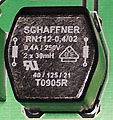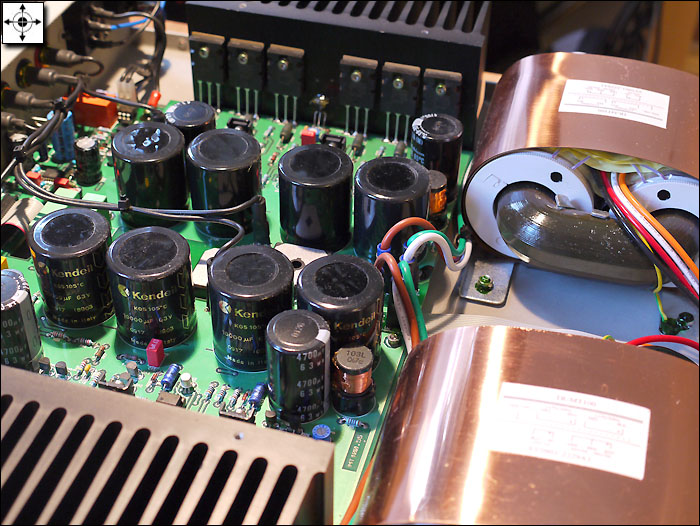This review page is supported in part by the sponsors whose ad banners are displayed below |
 |
 |
 |
Metronome mounts its modified Philips CDM12 PRO 2 V6.8 transport to a black acrylic plinth. That plinth floats on three suspension stanchions whose triangulated foot print mirrors the wider stance of the three chassis footers on both the player and amplifier (of identical height and width as the player, the MT One chassis is a bit deeper as shown below).
The top covers on both machines use heavy rolled steel that's been painted a silver grey.
|
|
|
 |
The transport-specific servo control circuits are naturally hidden beneath the central assembly.
|
 |
The provided valves in the output buffer are Philips JAN issue.
|
 |
Metronome's new drive shaft for the Philips transport is turned stainless steel and "a continuous ground link from the disk surface to electrical earth prevents buildup of static charges on the CD to avoid parasitic ESD and improve operating conditions for the electronic and optical components".
The batteries for the stylish remote control are two watch-style 3V CR2025 units. Remote functions besides direct track access and the usual also include scan, shuffle and repeats between user-set A/B points.
|
|
|

|
| This view of the non-tube version shows the company's trademark transport suspension from above. Converter resolution is 24/192 with a 120dB S/N ratio. The S/PDIF output is via RCA as are the analog outputs (the Signature non-tube version and the T add XLRs). Overall dimensions are 450 x 120 x 425mm. |
|
|
 |
|
 |
Voltage regulation involves three Indian Talema transformers from Amveco Magnetics and six different regulators.
|
 |
Behind the AC input, a small Schaffner filter with two 38mH coils handles EMI rejection. |
|
| An adjacent British Arcoelectric switch easily converts from 230V operation to 115V. |
|
|
| |
|
|
|
|
With its mounting of the two copper-sleeved 400VA transformers behind the face plate, the MT One integrated is quite front heavy. Around back, it sports 3 x RCA and 1 x XLR relay-switched inputs and 1 x RCA pre-out - plus the obligatory 5-way binding posts, IEC power inlet and power mains rocker. The simple black acrylic display in the face plate's center has four silvery push buttons with white identifiers - volume up/down, input up/down. The inputs don't loop in an endless circle but click through from 1 - 4 and back again.
The selected input confirms as A1 - A4 for just a second before the display reverts to showing the permanent 2-digit volume readout again. If you approach the amp not knowing which input is selected, you must trigger an input control. This calls up the input display but naturally also switches said input. Such a lack of permanent visual confirmation for input selection is truly peculiar. How did this pass muster with multiple engineers signing off on each project? The upcounting 0 to 99 volume setting remains set to whatever value is selected and can't be defeated.
|
|
|
 |
|
To deliver its specified 100 watts per channel into 8 ohms in class AB, the dual mono MT One runs six Toshiba 2SC5200 transistors per side while 80,000 microfarad of capacitance are provided by Kendeil and Nichicon units. Class A bias is very low (5 watts) and the overall chassis remains cool even with constant use. Bandwidth linearity is specified as 1Hz to 100kHz ±0.1dB. |
|
| |

|
Back outside, no invocation of Giner's industrial design skills can persuasively explain away why there are eight raised hex bolts with washers sticking out from the MT One's top cover.
|

|
|
The three per cheek duplicate the two each of the CD One. While less objectionable on the sides, they still could have gone flush as do most competitors for their fasteners if they cannot avoid them outright on the top (which incidentally the CD One does manage).
While the general impression of this machine is one of understated elegance, this specific item curiously fails the grade. While I'm on nits, the display can't be dimmed and the exposed heat sink edges are sharper than desirable. Due to chassis depth and lack of frontal power or standby switching, standard shelf installations could make reaching the power mains on the back quite awkward. On my 230V wall power, the two mains transformers elicited a bit of mechanical hum which a delivering Cyrill Dolganoff diagnosed as "that's normal". Though the inputs are relay switched, the remote can't control them and while the CD player offers remote-triggered standby shut-down, the integrated amplifier does not. In short, certain items remain mildly idiosyncratic. But then there's always le son... |
|
|
|
|
 |
| |
 |